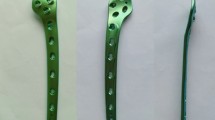Abstract
The mechanical performance and the stress shielding effects of the Howmedica Spherolock MKII implant were evaluated. Three types of stable proximal femoral fractures were created in composite femurs and fixed with the nail-plate. The femurs were loaded to failure, and the yield strength, stiffness, and failure modes were noted. Additional intact composite femurs were fitted proximally with strain gauges, and the strain was examined under load. The femurs then underwent intertrochanteric fracture, plating, and re-testing. Comparative analysis showed that while the Spherolock system is less strong and stiff than other commonly used implants, it provides excellent and uniform load transfer across the fracture site. Varus rotation of the femoral head under load tended to open the fracture gap and localize the resultant load medially. Stress shielding of the calcar was less than 25% of the applied load even in the worst case. This very low stress shielding behavior was attributed mainly to the implant's low stiffness.
Similar content being viewed by others
References
American Society for Testing and Materials (1992) Annual book of standards, Part 384, Designation F. ASTM, Philadelphia, pp 110–111
Apel DM, Patwardhan A, Pinzur MS, Dobozi WR (1989) Axial loading studies of unstable intertrochanteric fractures of the femur. Clin Orthop 246:156–164
Chang WS, Zuckerman JD, Kummer FJ, Frankel VH (1987) Biomechanical evaluation of anatomic reduction versus medial displacement osteotomy in unstable intertrochanteric fractures. Clin Orthop 225:141–146
Clark DI, Crofts CE, Saleh M (1990) Femoral neck fracture fixation: comparison of a sliding screw with lag screws. J Bone Joint Surg [Br] 72:797–800
Den Hartog BD, Bartal E, Cooke F (1991) Treatment of the unstable intertrochanteric fracture. Effect of the placement of the screw, its angle of insertion, and osteotomy. J Bone Joint Surg [Am] 73:726–733
Goodman SB, Davidson JA, Locke L, Novotny S, Jones H, Csongradi JJ (1992) A biomechanical study of two methods of internal fixation of unstable fractures of the femoral neck. A preliminary study. J Orthop Trauma 6:66–72
Jacobs RR, McClain O, Armstrong H (1980) Internal fixation of intertrochanteric hip fractures: a clinical and biomechanical study. Clin Orthop 146:62–70
Larsson S, Elloy M, Hansson LI (1988) Fixation of unstable trochanteric hip fractures. A cadaver study comparing three different devices. Acta Orthop Scand 59:658–663
Larsson S, Elloy M, Hansson LI (1988) Stability of osteosynthesis in trochanteric fractures. Comparison of three fixation devices in cadavers. Acta Orthop Scand 59:386–390
Mahomed N, Harrington I, Kellam J, Maistrelli G, Hearn T, Vroemen J (1994) Biomechanical analysis of the gamma nail and sliding hip screw. Clin Orthop 304:280–288
Meislin RJ, Zuckerman JD, Kummer FJ, Frankel VH (1990) A biomechanical analysis of the sliding hip screw: the question of plate angle. J Orthop Trauma 4:130–136
Müller ME, Allgöwer M, Schneider R, Willenegger H (1993) Manuale dell'osteosintesi. tecniche raccomandate dal gruppo AO. Springer, Berlin Heidelberg New York, pp 522–529
Pipino F, Calderale PM, Molfetta L (1993) Spherholock: a new osteosynthesis advice in the treatment of femoral trochanteric region fractures. (Abstract) 1st European Congress of Orthopedics, Paris, April 1993
Ramser JR Jr, Mihalko WM, Carr JB, Beaudoin AJ, Krause WR (1993) A comparison of femoral neck fixation with the reconstruction nail versus cancellous screws in anatomic specimens. Clin Orthop 290:189–196
Rosenblum SF, Zuckerman JD, Kummer FJ, Tam BS (1992) A biomechanical evaluation of the Gamma nail. J Bone Joint Surg [Br] 74:352–357
Springer ER, Lachiewicz PF, Gilbert JA (1991) Internal fixation of femoral neck fractures. A comparative biomechanical study of Knowles pins and 6.5-mm cancellous screws. Clin Orthop 267:85–92
Swiontkowski MF, Harrington RM, Keller TS, Van Patten PK (1987) Torsion and bending analysis of internal fixation techniques for femoral neck fractures: the role of implant design and bone density. J Orthop Res 5:433–444
Szivek JA, Gealer RL (1991) Technical note: comparison of the deformation response of synthetic cadaveric femora during simulated one-legged stance. J Appl Mat 2:277–280
Tencer AF, Johnson KD, Johnston WC, Gill K (1984) A biomechanical comparison of various methods of stabilization of subtrochanteric fractures of the femur. J Orthop Res 2:297–305
Author information
Authors and Affiliations
Rights and permissions
About this article
Cite this article
Ramer, M., Viceconti, M., Toni, A. et al. Biomechanical validation of a new nail-plate for the repair of stable proximal femoral fractures. Arch Orthop Trauma Surg 116, 137–142 (1997). https://doi.org/10.1007/BF00426062
Received:
Issue Date:
DOI: https://doi.org/10.1007/BF00426062




